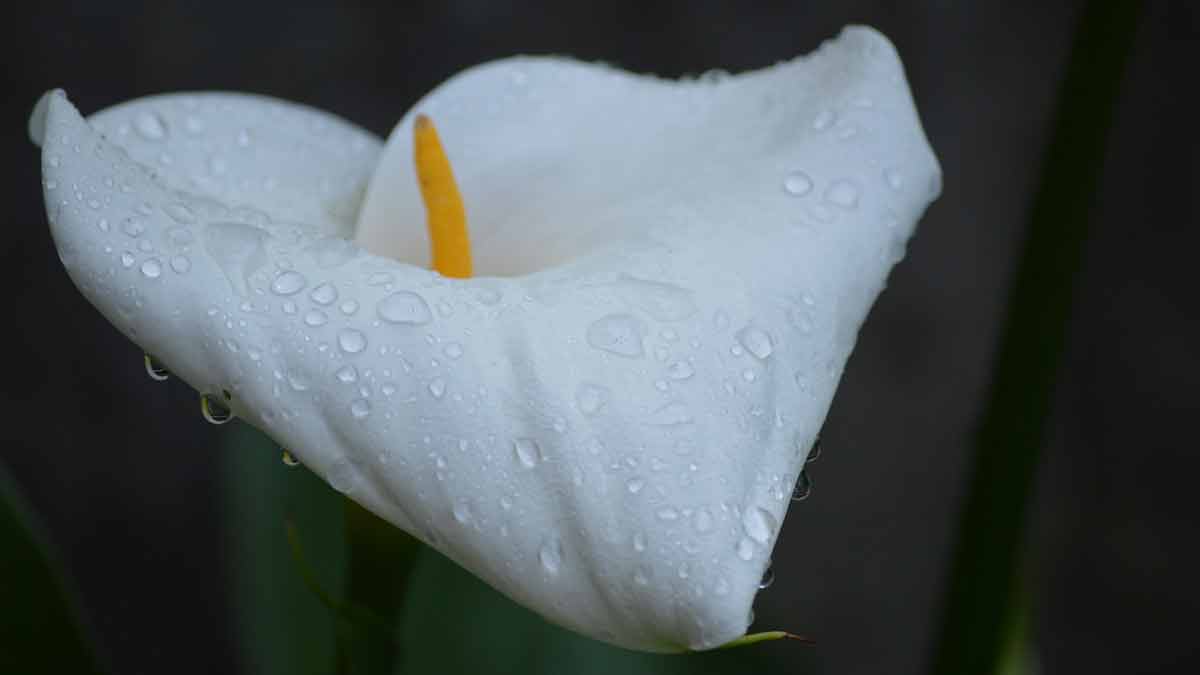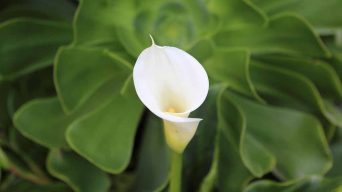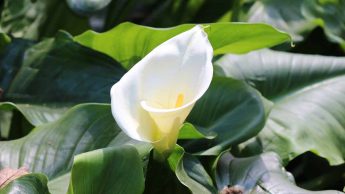Water Calla Lilies sparingly after planting. Once established, water once a week or more in hot and dry conditions. Potted Calla Lilies need frequent watering but not soggy soil. Keep soil moist but not waterlogged to prevent bulb rot. Provide bright light and normal room temperature.
Houseplants, such as Calla Lilies, are a great way to bring a bit of beauty and elegance into your home, as they are easy to care for and can tolerate a wide range of temperatures, making them ideal for both indoor and outdoor spaces.
Knowing how often to water these beautiful flowers is crucial for maintaining their beauty and health.
In this guide, we will explore the factors affecting the watering frequency of Calla Liliy plants and provide expert tips on keeping your plants thriving in various seasons and environments.
Factors Influencing Calla Lily Watering Frequency
Various factors influence the frequency with which you should water your calla lilies.
Proper Calla lily care is crucial to ensure they receive sufficient water, light, and nutrients to thrive.
The frequency of watering should be adjusted based on factors such as weather and climate conditions, pot size, soil type, temperature, humidity, and the amount of direct sunlight the plant receives.
Understanding these factors will help your calla lilies thrive and bloom beautifully.
1. Climate And Weather Conditions
Climate and weather conditions are crucial in determining the optimal watering frequency for your Calla Lilies.
In their native habitat of South Africa, Calla lily plants experience a Mediterranean or subtropical climate, which is characterized by hot, dry summers and cool, wet winters. To replicate these conditions when growing Calla lilies in other regions, it’s important to adjust the watering frequency accordingly.
These elegant plants thrive best in mild climates where temperatures range between 60-75°F (15-24°C) with consistent humidity levels.
For example, if you live in a region that experiences ample rainfall or high humidity throughout the growing season, it’s essential to adjust your watering schedule accordingly.
In contrast, those who reside in arid and dry areas must be extra vigilant about providing their Calla Lilies with sufficient hydration.
In order to ensure that Calla Lilies growing in arid and dry areas have sufficient hydration, gardeners must be mindful of the soil moisture levels and water the Calla Lilly bulbs regularly, making sure that the soil is moist but not soggy.
2. Soil Type And Quality
Soil type and quality are crucial factors that determine the watering frequency of Calla Lily plants, as they directly impact the moisture retention capacity of the soil.
This elegant flower thrives in well-draining, nutrient-rich soil with a slightly acidic pH level between 6.0 and 6.5.
Incorporating organic matter like compost or peat moss into your garden bed can improve drainage and fertility, promoting healthy root development for your calla lilies.
If you’re growing them in pots, choose a high-quality potting mix designed for container plants.
It’s important to use a potting mix that contains a balanced blend of nitrogen, phosphorus, and potassium to ensure that your plants get the nutrients they need to thrive.
This will help maintain consistent moist conditions without risking overwatering.
3. Pot Size And Material
Pot size and material affect the frequency Calla Lily plants need to be watered.
When choosing a container for your calla lilies, it is essential to consider the pot’s capacity to hold moisture and provide adequate space for the rhizomes to grow.
Smaller pots can lead to quicker soil drying, requiring more frequent watering than larger containers.
For instance, plastic pots retain water longer than porous materials like terracotta or clay that allow air circulation and evaporation.
As a result, you may need to water Calla Lilies planted in terracotta pots more frequently than those potted using plastic or glazed ceramic containers.
4. Sunlight Exposure
Sunlight exposure is a critical factor affecting how often you water your Calla Lily plants.
While Calla Lilies grow best in full sun, too much sunlight can dry out the soil and increase their watering needs.
In hot climates or during summer, monitoring the soil moisture levels and adjusting your watering frequency accordingly is essential.
On the other hand, partial shade can help retain moisture in the soil and reduce evaporation rates.
Placing indoor potted plants near a window with bright but indirect sunlight can provide enough light for optimal growth without drying out the soil too quickly.
Identifying Signs Of Underwatering And Overwatering
Learn how to identify the signs of underwatering and overwatering in calla lilies to ensure optimal growth.
Wilted leaves and flowers may indicate underwatering, whereas yellowing leaves and root rot may result from overwatering.
By recognizing these symptoms, you can adjust your watering habits and take necessary measures to prevent your plants from being harmed.
Symptoms Of Underwatering
When a Calla Lily is not getting enough water, it will show symptoms that can help you identify the problem.
Here are some signs of underwatering to watch out for:
- Dry or wilting leaves: When the plant lacks water, the first part to show symptoms is usually the leaves. They start to dry up and wilt, indicating that they need moisture.
- Brown tips on leaves: If the tips of your Calla Lily leaves turn brown and crispy, it may be a sign that the plant is not getting enough water.
- Yellowing leaves: Another common symptom of underwatering is the yellowing or browning of the leaves. This happens because the plant cannot get enough nutrients from the potting soil without enough water.
- Stunted growth: When a Calla Lily is not receiving enough water, it may stop growing altogether or grow slower than usual.
- Drooping stems: A sure sign of dehydration in Calla Lilies is drooping stems. If your plant looks limp or droopy, try watering it thoroughly to see if this fixes the issue.
Remember that these symptoms can also be caused by other factors, such as pests or diseases, so check for any other problems before assuming that your Calla Lily needs more water.
Symptoms Of Overwatering
Overwatering is one of the common problems that plant enthusiasts face while caring for Calla Lilies.
Here are some of the symptoms that indicate overwatering:
- Yellowing leaves – If you notice that the leaves of your calla lily are turning yellow or brown, it could be due to overwatering.
- Wilting – Overwatered calla lily plants may show wilting, often mistaken as a sign of underwatering. The leaves and stems become soft and limp, indicating the plant struggles to absorb water.
- Fungal growth – Overwatered plants create the perfect environment for fungi like mold to grow on leaf surfaces or in the soil.
- Root rot – Rot occurs when there’s too much moisture in the soil, leading to decay and death of the root system, resulting in stunted growth of the plant.
- Slow growth – Overwatered plants tend to grow slowly since their roots struggle to handle too much water compared to nutrients.
How Often Should You Water Your Calla Lily?
Watering Calla Lily plants properly is crucial for their growth and development. The frequency of watering often depends on several factors, including weather conditions, pot size, soil quality, and sunlight exposure.
As a general rule, it is recommended to water your Calla Lily once or twice a week during the growing season.
To ensure you are watering your Calla Lily correctly, start by checking the top inch of soil in the pot or garden bed.
Using your finger to test the soil, press it into the pot or garden bed to determine if it is dry to the touch and needs watering; if it feels dry, then it’s time to water.
Additionally, be mindful not to overwater or underwater your plants, as both can cause harm.
Remember that outdoor Calla Lilies may need more frequent watering than indoor ones due to increased sunlight and wind exposure.
On the other hand, indoor plants can withstand longer periods between watering sessions because of less sun exposure and room temperature fluctuations.
Watering Calla Lilies In Different Seasons
Calla Lilies require more frequent watering in the summer due to higher temperatures and increased evaporation, but what about fall, winter, and spring?
Read on to find out how to water your calla lily during every season.
Summer
Calla Lilies require more frequent watering during summer due to warmer weather and higher evaporation levels.
Generally, they should be watered once or twice weekly, depending on how quickly their soil dries out.
It’s important not to let the soil dry out completely, as this can cause stress and damage to the plant.
In addition to regular watering during summertime, you can use organic mulch such as straw or wood chips around your plants to help retain moisture in their soil.
This will also protect their roots from fluctuating temperatures and maintain good air circulation around them.
To ensure that your Calla Lilly plants are healthy and thriving, it is important to fertilize them regularly with a balanced fertilizer to provide the necessary nutrients for growth while also protecting their roots from fluctuating temperatures and maintaining good air circulation around them.
Fall
Calla Lily plants prepare for their dormant period as the weather cools and days become shorter.
During this time, reducing watering is essential to prevent the rhizomes’ rotting gradually.
Furthermore, overwatering during fall can lead to diseases that may destroy the plant entirely.
While reducing the watering frequency, ensure you do not let the soil dry out completely, since this can negatively impact next year’s blooming season.
Additionally, promptly remove all dead leaves and flowers as they could attract pests or even invite rotting organisms during winter storage.
Winter
Hardiness zones 8-10 are ideal for winter Calla Lilies, as they are winter hardy in these zones and can withstand the cold temperatures, preventing pests and rotting organisms from invading during winter storage.
During winter, Calla Lilies enter a state of dormancy, requiring less water and inviting fewer rotting organisms due to their decreased metabolic activity and slowed growth.
It’s important not to overwater the plant during this period, as it can lead to root rot.
As a rule of thumb, water your Calla lily once per week during the winter months or whenever the soil feels completely dry.
During winter, ensure that your indoor Calla Lily plant is placed in a well-lit area with plenty of natural light to avoid frost damage, as temperatures below freezing can cause the leaves to become discolored and the plant to become weakened.
If you notice your plant getting too little light, consider changing its location to a spot closer to a window or adding artificial grow lights to supplement the natural light in its current location.
Spring
During the spring, calla lily plants start emerging from their dormant period, and it’s important to ensure they have enough moisture to fuel new growth.
As the weather starts warming up, it’s best to water your Calla Lilies every four to five days.
However, ensure not to overwater them as this can lead to root rot and other problems.
It’s also essential during this time of the year that you choose a well-draining soil mix that will allow excess water to escape easily, preventing any waterlogging issues.
Watering Calla Lilies In Different Growing Environments
Knowing the proper watering techniques is crucial to growing Calla Lily plants.
The watering frequency of calla lilies depends on the growing environment.
Outdoor Calla Lily plants require watering when the top inch of the soil is dry.
In contrast, indoor potted lilies need more frequent watering to ensure the soil stays evenly moist.
Read on to learn more about watering Calla Lilies in different growing environments.
Outdoor Gardens
When growing Calla Lilies in outdoor gardens, it is essential to ensure they receive adequate moisture without waterlogging.
As a rule of thumb, it’s best to water them when the top inch of soil feels dry.
However, factors such as climate and soil quality can influence watering frequency.
In hot and dry climates, for example, they may require more frequent watering than those grown in cooler or more humid conditions.
Additionally, soils with heavy clay content tend to retain moisture longer than well-draining soils, so gardeners must adjust their watering routine accordingly.
If possible, try not to wet the foliage or flowers when watering Calla Lilies, as this can promote fungal growth and disease.
Indoor Pots
Indoor calla lilies can add an elegant touch to any house, but they require specific care to thrive.
When growing calla lilies in indoor pots, it’s crucial to select a well-draining potting mix. Opt for a blend of organic materials like peat moss, compost, and sand, along with perlite or vermiculite to aerate the soil and ensure adequate oxygen for the roots.
Ensure the pot has ample drainage holes at the bottom to prevent waterlogging. Excess water can lead to root rot and, ultimately, the demise of the plant.
Consistently water your potted calla lilies, allowing the top inch of soil to dry before each watering. Be cautious not to overwater and avoid letting the soil become excessively soggy.
For optimal growth and blooming, place your indoor houseplants in a well-lit area of your home. If natural light is limited, consider using supplemental lighting to provide the ideal light conditions.
Final Thoughts
When given the proper care and attention, calla lilies will produce beautiful blooms that will last for weeks, providing a stunning display of vibrant colors and lush foliage that will make any garden shine and bring joy to all who witness its majestic beauty.
By considering climate, soil type, and pot size, you can determine how often to water your plants.
Remember to look for signs of both underwatering and overwatering and adjust your watering schedule accordingly.
Whether you’re growing calla lilies indoors or outdoors, in pots or the ground, providing them with adequate moisture is essential for their growth and longevity.







